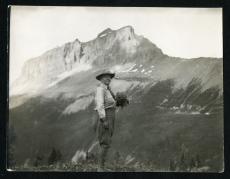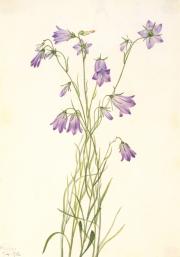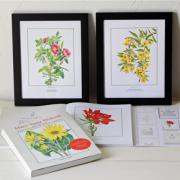
 Mary Morris Vaux was born into a well-to-do Quaker family in Philadelphia and attended the Friends School. She planned to enroll in Bryn Mawr College, but when her mother died, she stayed home to care for her father and brothers, as was expected of 19th century young women. The family spent vacations in Canadian Rockies, so her father could pursue his amateur interest in geology. Mary brought her sketching pads and watercolors so she could capture the beautiful wild flowers she found along the trails. Botany and drawing were considered very appropriate avocations for educated young women, although most sat in their gardens rather than scale peaks and cross glaciers. Mary was far more adventurous – in 1913, she climbed Mount Robson, the highest peak in the British Columbia Rockies. Mount Mary Vaux, some 10,881 feet high, was named in her honor. Despite those adventures, her life was fairly circumscribed, centered around family and church.
Mary Morris Vaux was born into a well-to-do Quaker family in Philadelphia and attended the Friends School. She planned to enroll in Bryn Mawr College, but when her mother died, she stayed home to care for her father and brothers, as was expected of 19th century young women. The family spent vacations in Canadian Rockies, so her father could pursue his amateur interest in geology. Mary brought her sketching pads and watercolors so she could capture the beautiful wild flowers she found along the trails. Botany and drawing were considered very appropriate avocations for educated young women, although most sat in their gardens rather than scale peaks and cross glaciers. Mary was far more adventurous – in 1913, she climbed Mount Robson, the highest peak in the British Columbia Rockies. Mount Mary Vaux, some 10,881 feet high, was named in her honor. Despite those adventures, her life was fairly circumscribed, centered around family and church.

 That same year as she scaled Mount Robson, she embarked upon quite a different adventure. She told her father she planned to marry a paleontologist they had met in the Rockies. Her father rejected the notion summarily and refused to attend the wedding. He was very fond of his 53 year old unmarried daughter, who had cared for him lovingly since her mother died. He also did not much care for the fellow she intended to marry – Charles Doolittle Walcott (1850-1927) paleontologist and Secretary of the Smithsonian. He regarded Walcott as something of a gold-digger and he was not a Quaker. At 64 years, Walcott had been widowed twice and had four children. Walcott's family was no happier about the wedding. His daughter Helen had cared for her father and brothers after her mother died and did not want an interloper taking her place.
That same year as she scaled Mount Robson, she embarked upon quite a different adventure. She told her father she planned to marry a paleontologist they had met in the Rockies. Her father rejected the notion summarily and refused to attend the wedding. He was very fond of his 53 year old unmarried daughter, who had cared for him lovingly since her mother died. He also did not much care for the fellow she intended to marry – Charles Doolittle Walcott (1850-1927) paleontologist and Secretary of the Smithsonian. He regarded Walcott as something of a gold-digger and he was not a Quaker. At 64 years, Walcott had been widowed twice and had four children. Walcott's family was no happier about the wedding. His daughter Helen had cared for her father and brothers after her mother died and did not want an interloper taking her place.
 Despite the negative response of their families, Mary and Charles married and shared many happy years, based on their mutual love of natural history exploration. Mary Walcott quickly became part of the Smithsonian family and the Quaker community in Washington. In the 1920s, when her husband launched a fund-raising campaign, Mary Walcott found a way to contribute. She published a five volume set of her drawings of North American wild flowers, between 1925 and 1928, with proceeds going to the Smithsonian's endowment. Her beautiful and accurate drawings have been displayed in exhibits and republished several times since then. In 2014, the Smithsonian Institution Press with Smithsonian Institution Libraries reprinted a selection of them in a single volume. It is nice to know that I can browse through them in the chill of winter and look forward to that sunny spring day when they will reappear at a pond's edge or in a mountain glen.
Despite the negative response of their families, Mary and Charles married and shared many happy years, based on their mutual love of natural history exploration. Mary Walcott quickly became part of the Smithsonian family and the Quaker community in Washington. In the 1920s, when her husband launched a fund-raising campaign, Mary Walcott found a way to contribute. She published a five volume set of her drawings of North American wild flowers, between 1925 and 1928, with proceeds going to the Smithsonian's endowment. Her beautiful and accurate drawings have been displayed in exhibits and republished several times since then. In 2014, the Smithsonian Institution Press with Smithsonian Institution Libraries reprinted a selection of them in a single volume. It is nice to know that I can browse through them in the chill of winter and look forward to that sunny spring day when they will reappear at a pond's edge or in a mountain glen.
Related Resources
- Mary Vaux Walcott, Artist, Smithsonian American Art Museum artist database
- Charles Doolittle Walcott, Smithsonian Secretary, Institutional History Division, Smithsonian Institution Archives
- Mary M. Vaux, a picture journal, The Palaeontological Society and Royal Museum of Ontario
Related Collections
- Accession 92-006 - Mary Vaux Walcott, North American Wildflowers Prints, 1925, Smithsonian Institution Archives
Produced by the Smithsonian Institution Archives. For copyright questions, please see the Terms of Use.

Leave a Comment